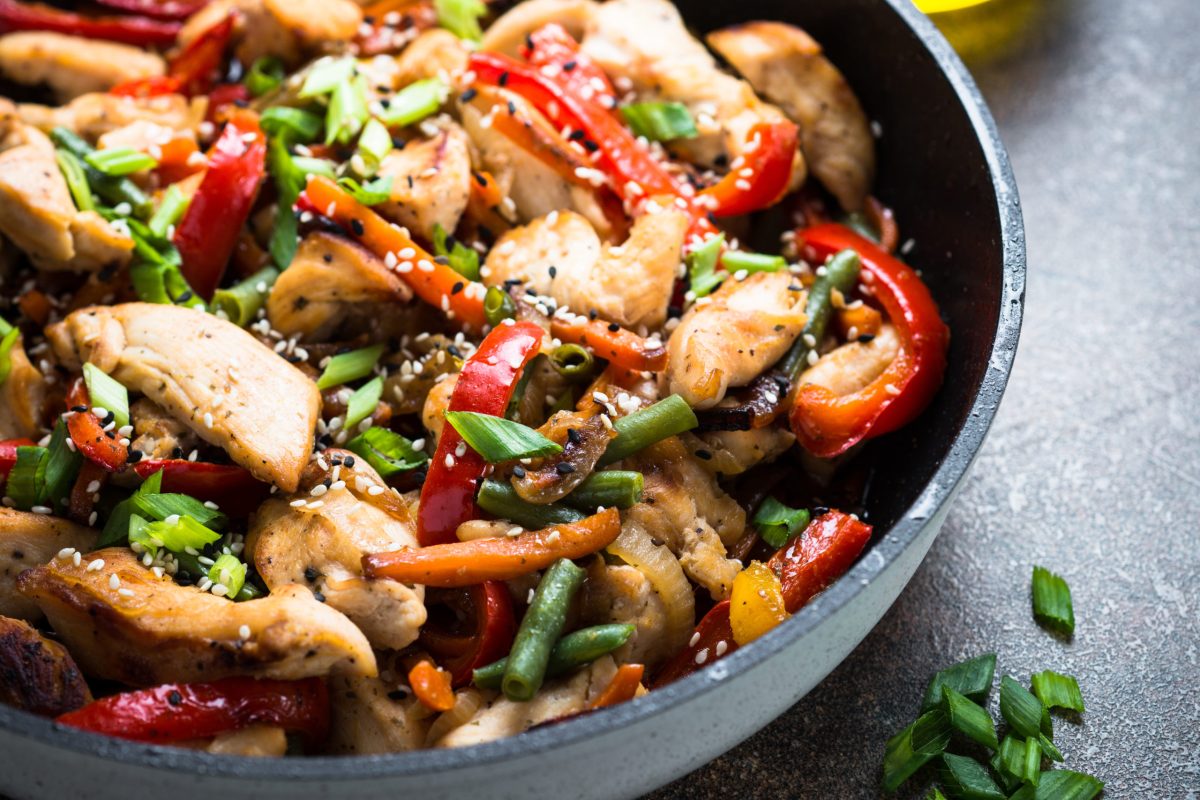Imagine vibrant colors dancing on your plate: crisp-tender broccoli florets, juicy bell peppers, succulent tofu glistening with a rich, savory sauce. This isn’t just a meal; it’s a weeknight escape, a celebration of fresh flavors and effortless cooking. Learn how to craft delicious and healthy flexitarian stir-fries that are quick to prepare, packed with nutrients, and adaptable to any taste or dietary need. From mastering the art of wok hei to choosing the perfect protein and sauce, this guide unlocks the secrets to creating restaurant-quality stir-fries in the comfort of your own kitchen.
We’ll explore the principles of flexitarian eating, guiding you through a gradual transition towards more plant-based meals without sacrificing flavor or convenience. Discover a world of versatile vegetables and protein options, learning to expertly combine them with a range of exciting sauces. We’ll delve into the techniques that elevate a simple stir-fry into a culinary masterpiece, including essential tips for achieving that coveted wok hei—the smoky, slightly charred aroma that defines authentic stir-fries. Finally, we’ll equip you with three delicious, weeknight-friendly recipes, complete with step-by-step instructions and meal-prep suggestions to streamline your cooking process.
Understanding Flexitarian Diets
The flexitarian diet, a portmanteau of “flexible” and “vegetarian,” offers a vibrant and adaptable approach to eating. It’s not a rigid regimen but a mindful shift towards incorporating more plant-based meals while still allowing for occasional consumption of meat, poultry, and seafood. This flexibility makes it a highly accessible and sustainable dietary pattern for many.
Flexitarian eating prioritizes fruits, vegetables, legumes, whole grains, and nuts as the foundation of the diet. The benefits are numerous, encompassing improved heart health due to reduced saturated fat intake, enhanced weight management through increased fiber and nutrient density, and a lower risk of type 2 diabetes due to improved blood sugar control. Furthermore, a flexitarian approach often leads to a reduction in environmental impact compared to a purely meat-centric diet, owing to the lower carbon footprint associated with plant-based foods.
Examples of Flexitarian Meals
A flexitarian approach allows for creative culinary exploration. Imagine a vibrant quinoa salad bursting with roasted sweet potatoes, chickpeas, and kale, tossed in a lemon-tahini dressing, perhaps complemented by grilled chicken or shrimp for added protein. Alternatively, a hearty lentil soup, rich with carrots, celery, and warming spices, can be enhanced with a dollop of plain yogurt or a sprinkle of crumbled feta cheese. Even classic dishes can be adapted; a traditional beef stir-fry can be easily transformed into a delicious and equally satisfying tofu and vegetable stir-fry, maintaining the familiar flavors while boosting the nutritional profile. The possibilities are as diverse and exciting as the individual’s palate.
Transitioning to a More Plant-Based Diet
Successfully transitioning to a more plant-based approach requires a gradual and mindful shift, rather than an abrupt overhaul. Begin by incorporating one or two plant-based meals per week, substituting meat in familiar dishes with alternatives like lentils, beans, tofu, or tempeh. Explore new recipes featuring seasonal vegetables and fruits, experimenting with different flavor combinations and cooking techniques. Gradually increase the frequency of plant-based meals as comfort and confidence grow. Focus on adding more plant-based foods to your diet, rather than solely restricting meat consumption. This approach makes the transition smoother and more sustainable in the long term. Remember that small, consistent changes accumulate significant benefits over time.
Choosing the Right Ingredients
Crafting delicious and nutritious flexitarian stir-fries hinges on selecting the perfect blend of vibrant vegetables, flavorful protein sources, and aromatic sauces. The key is to choose ingredients that complement each other in texture and taste, creating a symphony of flavors in every bite. This section will guide you through selecting the optimal components for your weeknight stir-fry masterpieces.
Versatile Vegetables for Stir-Fries
A rainbow of vegetables adds both visual appeal and nutritional value to any stir-fry. Consider texture and cooking time when making your selections. Some vegetables, like broccoli and carrots, require slightly longer cooking times than others, such as bell peppers and snap peas. Aim for a mix to ensure even cooking and a delightful variety of textures.
- Broccoli florets: Their firm texture holds up well during stir-frying, and they develop a satisfyingly tender-crisp bite.
- Bell peppers (various colors): Their sweetness and vibrant hues add visual flair and a delightful crunch.
- Snap peas: These offer a delicate sweetness and a satisfying snap.
- Carrots: Their sweetness balances the other flavors, and their firmness provides a pleasant contrast in texture.
- Snow peas: Similar to snap peas, but slightly more tender.
- Mushrooms (shiitake, cremini, button): Earthy and umami-rich, mushrooms add depth of flavor.
- Onions (white, yellow, red): Their sharpness adds a base note to the stir-fry.
- Bok choy: Its slightly bitter yet subtly sweet flavor adds complexity.
- Zucchini: Adds a mild, refreshing element.
- Spinach: Wilts quickly, adding a touch of greenery at the end of cooking.
Protein Powerhouses for Flexitarian Stir-Fries
The beauty of flexitarian cooking lies in its flexibility. You can easily incorporate a variety of protein sources to suit your dietary preferences and cravings. Lean meats offer a quick cooking option, while tofu and tempeh provide a plant-based alternative packed with protein and nutrients.
- Chicken breast (cubed or sliced): A lean and versatile protein that cooks quickly.
- Shrimp: Adds a delicate sweetness and cooks rapidly.
- Tofu (firm or extra-firm): A highly versatile plant-based protein that absorbs flavors beautifully. Pressing it beforehand removes excess water, resulting in a firmer texture.
- Tempeh: Another excellent plant-based option with a slightly nutty flavor and firm texture.
- Beef (sirloin or flank steak, thinly sliced): Adds a rich, savory flavor. Choose lean cuts for a healthier option.
- Pork (tenderloin or loin, thinly sliced): A flavorful and versatile option that cooks quickly.
Stir-Fry Sauce Showdown
The sauce is the star of the show, binding all the ingredients together in a harmonious blend of flavors. Here’s a comparison of popular stir-fry sauces:
| Sauce Type | Flavor Profile | Ingredients | Best Pairings |
|---|---|---|---|
| Soy Sauce | Savory, salty, umami | Soybeans, wheat, salt, water | Chicken, beef, tofu, vegetables |
| Teriyaki | Sweet, savory, slightly tangy | Soy sauce, mirin, sugar, sake (optional) | Chicken, shrimp, vegetables |
| Peanut Sauce | Nutty, creamy, savory | Peanut butter, soy sauce, rice vinegar, honey or maple syrup, lime juice | Tofu, tempeh, chicken, vegetables |
| Sweet and Sour | Sweet, tangy, slightly spicy | Vinegar, sugar, ketchup, soy sauce, ginger, garlic | Chicken, pork, shrimp, vegetables |
Recipe Presentation and Serving Suggestions

Elevating your flexitarian stir-fry from a simple weeknight meal to a visually stunning and delicious experience involves thoughtful plating and complementary accompaniments. A beautifully presented dish enhances the dining experience, making even a simple stir-fry feel special.
A well-plated stir-fry is a symphony of colors, textures, and aromas. Consider the interplay of vibrant vegetables, the glossy sheen of a flavorful sauce, and the satisfying contrast of different textures – the crispness of broccoli, the tenderness of tofu, the satisfying chew of noodles.
Plating Techniques for Appealing Stir-Fries
Achieving an aesthetically pleasing presentation is surprisingly simple. Start by using a shallow bowl or plate to showcase the stir-fry’s colorful ingredients. Avoid overcrowding the plate; allow the components to breathe and create visual interest. Consider arranging the stir-fry in a slightly mounded shape, creating a sense of depth and dimension. A sprinkle of fresh herbs, such as cilantro or basil, adds a pop of color and freshness. A drizzle of sesame oil or a scattering of toasted sesame seeds can further enhance the visual appeal and add a subtle nutty flavor. Finally, consider the placement of any protein or prominent vegetables, strategically positioning them to draw the eye.
Complementary Side Dishes for Flexitarian Stir-Fries
The right side dish can elevate your flexitarian stir-fry to a complete and satisfying meal. Grains, particularly those with neutral flavors, provide a wonderful counterpoint to the bold flavors of the stir-fry.
- Steamed Rice: A classic pairing, white or brown rice offers a soft, neutral base that absorbs the delicious stir-fry sauce.
- Quinoa: This protein-rich grain adds a nutty flavor and fluffy texture, creating a more substantial and nutritious meal.
- Noodles: From thin rice noodles to hearty wheat noodles, noodles provide a different textural experience and can absorb the stir-fry sauce beautifully. Consider adding a touch of sesame oil or soy sauce to the noodles for extra flavor.
- Naan Bread: A warm, slightly charred piece of naan bread can be used to scoop up the flavorful stir-fry, adding another layer of texture and taste.
Visual Description of a Beautifully Plated Stir-Fry
Imagine a shallow, rustic-style bowl brimming with a vibrant stir-fry. Emerald green broccoli florets nestle beside fiery orange bell peppers and deep purple cabbage. Chunks of golden-brown tofu, glistening with a rich, dark soy-based sauce, are scattered throughout. The sauce itself is a glossy, dark mahogany color, catching the light and reflecting the vibrant colors of the vegetables. A sprinkle of finely chopped, bright green cilantro adds a pop of freshness, while a few toasted sesame seeds provide a contrasting texture and subtle nutty aroma. The overall effect is one of warmth, vibrancy, and deliciousness, promising a delightful culinary experience.
With the knowledge and recipes shared here, weeknight dinners transform from a chore into a culinary adventure. The vibrant colors, aromatic scents, and satisfying textures of flexitarian stir-fries will not only nourish your body but also delight your senses. Embrace the flexibility of this approach to eating, adapting recipes to your preferences and dietary needs. Experiment with different vegetables, proteins, and sauces to discover your own signature stir-fry creations. The journey to mastering the art of the flexitarian stir-fry is a delicious one, filled with creativity, convenience, and countless possibilities for flavorful and healthy meals.
User Queries
Can I use frozen vegetables in stir-fries?
Yes! Frozen vegetables are a convenient and cost-effective option. Just ensure they are thoroughly thawed and patted dry before adding them to the wok to prevent steaming.
How do I prevent my stir-fry from becoming soggy?
Use high heat, add ingredients in the correct order (starting with firmer vegetables), and don’t overcrowd the wok. Ensure your vegetables are dry before adding them to prevent steaming.
What can I do if I don’t have a wok?
A large, heavy-bottomed skillet or frying pan works well as a substitute. Just be sure to use high heat for optimal results.
Are there any good alternatives to soy sauce for those with soy allergies?
Coconut aminos, tamari (for those with mild soy sensitivities), or tamari alternatives are great soy sauce substitutes. You can also use a combination of other sauces like Worcestershire sauce and rice vinegar for a similar umami flavor.


